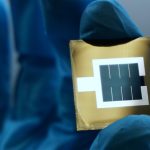Sign up for daily news updates from CleanTechnica on email. Or follow us on Google News!
Solar photovoltaic (PV) technology is the fastest growing energy industry and one of the most environmentally promising methods to obtain a sustainable energy system. It’s quite appealing to think that less than 1% farmland is required for agrivoltaics to meet 20% of US electric generation. Of course, there are issues to be managed with solar farms, including the task of avoiding panel shading and damage from vine and tree growth, which can cause reduced electricity production. Vegetation management with sheep is an emerging industry, as sheep and solar have multiple benefits for farmers.
Land productivity can be greatly increased because sheep grazing is constant, and added value that comes with choosing sheep as a vegetative detergent is generated by the PV.
Sheep and Solar at Work
The Boston Globe recently chronicled a pair of farmers from Fitchburg, Massachusetts as they kept watch over a flock of more than 200 sheep. Jesse and Elspeth Robertson-Dubois anticipated the expanding fuzzy huddle under a row of solar panels as the heat of the day rose. That row was part of the 15,000 solar panels that make up the Fitchburg Renewables solar farm. The project generates clean energy and feeds it into the Unitil grid. The site is also equipped with a 2.5 MW / 5.2 MWh battery energy storage system.
This farm was converted from an abandoned apple orchard 3 years ago into a 20-acre solar farm. The owner of the panels, solar company Nexamp, is leasing the land from the orchard owner for 25 years. The Robertson-Dubois family owns Finicky Farms, and they are paid by Nexamp for keeping the vegetation low. They also get to graze their herd, which they process and sell locally as lamb.
As the American Solar Grazing Association (ASGA) notes, farm incomes are down, and solar grazing allows farmers to increase and diversify revenues without taking land out of food production.
When solar farms use sheep instead of mowers for vegetation management, they minimize burning fossil fuels, and costs associated with labor are also reduced. Investment costs for a solar farm might include water tanks, troughs, a small water transfer pump water pump to fill the troughs, predator-proof fencing, and a charger to divide sections for rotational grazing.
The sheep eat the tall grass, weeds, and clover, and their chomping inhibits the vegetation from blocking the panels. Their steady consumption of forage on the land prevents grassy plants from growing high enough to block sunlight from reaching the panels, maintaining the productivity of the array. As they graze, the sheep also improve soil health, a benefit for plant biodiversity and other animals that feed there.
Sheep are the most appropriate ruminant species when it comes to vegetation management on solar farms because they are too small to damage the panels when rubbing against them, and they are not predisposed to chewing on wires or jumping on the panels, as goats would. Additionally, sheep are effective grazers, easily able to maneuver between panels and able to graze on steep slopes that are harder to reach for mowers.
For the sheep, the panels provide protection from heat, rain, and snow, with some sheep using the base of the structure as a scratching post during shedding season. Use of solar panels as a shading resource combines better animal welfare, generation of renewable energy, and animal production in the same area. This concept is termed “animal agrivoltaics.”
Sheep grazing behavior is dependent on the structure of the pasture, which is a combination of many factors, such as forage density and length, forage species, nutritional quality of the forage, plant vegetative stages, the presence of barriers to defoliation (e.g. stems and sheaths), and leaf blade fibrousness. The sheep try to optimize their forage intake, which affects their behavioral activities, such as selectivity. Sheep will eat forages of lower or higher nutritive quality, depending on the degree of selectivity. Of course, several factors, like management, regional climatic conditions, animal activity in the group, and the nutritive value and availability of the forage influence duration and intensity of sheep grazing and reducing vegetation beneath the solar panels.
So, too, do governmental policies affect the robustness of using sheep to manage solar farms. In 2018 Massachusetts zoomed in on the potential of solar with its financial incentive program, Solar Massachusetts Renewable Target (SMART), which requires utility companies to support the development of smaller solar projects. The increase of solar panels closer to the ground, instead of on the roofs of buildings, has produced what Elspeth Robertson-Dubois called a “beautiful symbiotic relationship” between agriculture and renewable energy, doubling the usefulness of a single plot of land.
Chip in a few dollars a month to help support independent cleantech coverage that helps to accelerate the cleantech revolution!
The Management of Sheep and Solar
Sheep can take the place of regular maintenance operations, reducing or even eliminating the use of herbicides, lawnmowers, and weed-eaters, which have negative impacts on the environment and can also damage PV systems.
Solar farm grazing reduces entry barriers for young and beginning farmers interested in sheep enterprises. Equipment investment costs for sheep grazing on solar sites ($30 per sheep and $77 per acre) are lower than for other pasture management systems, especially with perimeter fencing already in place. However, water access in the form of wells is an inexpensive measure over the lifetime of the solar array that developers may take to ease labor requirements for sheep flock managers and create well-intentioned and effective working relationships.
A 2022 study indicated that implementing managed sheep grazing significantly increased total carbon storage (10-80%) and available nutrients, and the magnitude of change correlated with the grazing frequency (1-5 years) at the study sites. Furthermore, it was found that sites that experienced consecutive annual grazing treatments benefited more than intermittently grazed sites.
Final Thoughts
Solar development and agricultural use can exist not only side-by-side, according to ASGA, but increasingly are found together.
- A farmer can add solar to their property and get steady income.
- Solar energy facilities can also collaborate with local farms and bee-keeping organizations to incorporate pollinator friendly plants and bee hives onto their sites.
- Responsible solar development can improve soil health, retain water, nurture native species, produce food, and provide even lower-cost energy to local communities.
- Sheep farmers have opportunities to contract for vegetation management of solar sites and thus increase farm viability.
Have a tip for CleanTechnica? Want to advertise? Want to suggest a guest for our CleanTech Talk podcast? Contact us here.
Latest CleanTechnica.TV Videos
[embedded content]
CleanTechnica uses affiliate links. See our policy here.
This post was originally published on 3rd party site mentioned in the title of this site






